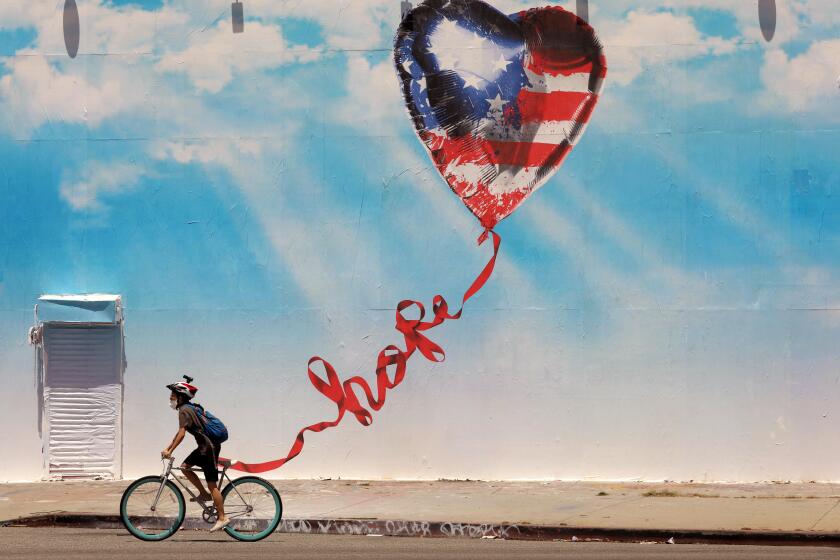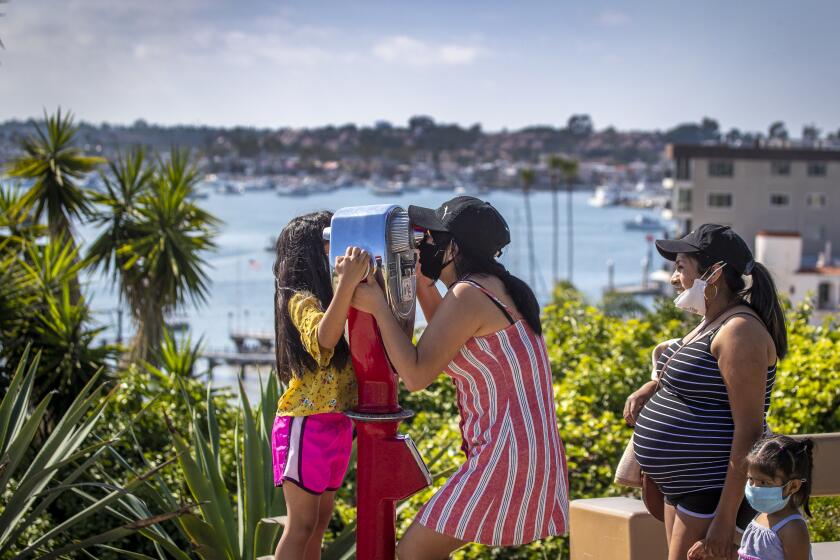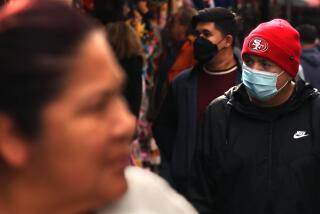Californians are losing their fear of the coronavirus, setting the stage for disaster

- Share via
As California began to rapidly reopen the economy, officials in Santa Cruz County decided the safe thing to do was keep its landmark beaches largely closed in the afternoons to prevent crowds that could spread the coronavirus.
But the public increasingly ignored the rules and demanded their summer on the sand, swimming, sunbathing and just hanging out. Unable to stop the crowds, county officials simply gave up.
“People are not willing to be governed anymore in that regard,” health officer Dr. Gail Newel said as the county rescinded its beach closure order last week.
Gov. Gavin Newsom on Wednesday ordered tougher restrictions on indoor activities for most of the state, marking a major step backward in the reopening and an attempt to slow an alarming rise of the coronavirus in 19 counties.
This is the problem California officials now face as they deal with a major surge in coronavirus cases tied to business reopenings, social gatherings and other factors, and hospitals are becoming increasingly crowded. As the public has become more accustomed to the pandemic, Californians have seemingly become less afraid of the highly contagious virus, even though it’s no less infectious than it was in the winter.
When California became the first state in the nation to impose a stay-at-home order on March 19, people listened.
Businesses ground to a halt and many stayed home as much as possible, watching as COVID-19 made a deadly march through places like New York and northern Italy.
We emptied the supermarkets as if preparing for the apocalypse. We sanitized our cellphones hourly. Some of us even wiped down groceries or left mailed packages alone for days, fearful that the virus might be left on surfaces.
California emerged months later a seeming coronavirus success story, with far fewer deaths than in other hot spots. But those bragging rights also brought complacency, and a demand that we return to old routines that could revive the devastated economy. Eventually, coronavirus cases and hospitalizations started rising rapidly.
“We were kind of victims of our own success,” said Dr. Peter Chin-Hong, professor of medicine and an infectious-diseases expert at UC San Francisco.
Government officials now must try to roll back some of the reopenings, hoping to avoid a disastrous July Fourth weekend that spreads infection even more quickly with social events and crowds.
Gov. Gavin Newsom this week ordered the closure of indoor restaurants, bars, wineries, movie theaters, zoos and museums in 19 counties, affecting more than 28 million Californians, or 72% of the state’s population. Beaches were ordered shut down by local government officials in Los Angeles, Orange, Ventura and Santa Barbara counties.
Getting more people to comply with a state order to wear masks in public remains a challenge. And many have become accustomed to being out in crowds after taking part in protests, seeing restaurants reopen and hosting social gatherings.
“California should be commended for doing so much well at the beginning. We really shut down, and I think we really got the right messages out,” said Dr. Kirsten Bibbins-Domingo, chair of UC San Francisco’s Department of Epidemiology and Biostatistics. “So why did we start going out?”
“We felt good about all that we had accomplished, not realizing that the virus never left us. The virus was just under control,” she said. And while the shutdown of society happened quickly, “it made us believe that we could open up in the same type of way.”
Many residents are torn — they understand the growing dangers of the coronavirus but also say the months in virtual lockdown took an emotional toll. Casey Parlette, a Laguna Beach resident, said he was torn about whether his city should have closed its beaches during the holiday weekend.
“I hear both sides of the argument ... but it’s a tough thing when everything is closed. When the beaches, trail heads, parks were closed, the only thing that was open was maybe your backyard, if you have one, and the middle of the street and that was pretty much it,” Parlette said.
“We were trying to figure out creative ways to get my 3-year-old son out and doing things,” he added. “But I think that there’s a certain amount of implicit responsibility that individuals need to take to not be part of the problem.”
California, however, is not yet in the same crisis as other states, such as Arizona and Florida. While the rate at which coronavirus tests are confirming infections in California over the last seven days is 6.9%, in Arizona it’s 24%, and in Florida it’s 16%.
Some experts say California can avoid disaster if it changes its behaviors now — without needing a return to the strictest stay-at-home order.
That’s partly because of our better understanding of the virus — physicians are able to provide better hospital care than they did in the pandemic’s earliest days.
But people also need to do a better job avoiding higher-risk activities. Experts say indoor bars are high-risk, as are large indoor gatherings.
Lower-risk activities involve meeting with friends or family outdoors, in smaller gatherings, for shorter periods of time, while wearing masks when not eating or drinking. San Francisco’s health order, for instance, allows outdoor gatherings but requires masks and urges social distancing and no more than 12 people for special gatherings and no more than six for a meal.
In L.A. County, the coronavirus crisis is still so severe that officials do not recommend gatherings outside one’s household. Newsom discouraged such gatherings this holiday weekend.
While L.A. County continues to ban gatherings beyond protests or religious services, the Bay Area is beginning to allow small group meet-ups.
It’s possible for us to change our habits. Wearing seat belts became California law in 1986. Smoking is no longer allowed in crowded public areas.
“Public health, when it does its work best, it’s not telling people what to do. It’s telling people how to keep themselves and their loved ones safe so people can make their decisions about how to do that,” Bibbins-Domingo said.
Lockdown fatigue is not a new phenomenon. During the 1918 flu pandemic, San Franciscans threw their masks into the air when they thought the pandemic was over, not realizing a new deadly wave of flu would hit within weeks, said Chin-Hong at UC San Francisco.
“People are afraid that history is going to repeat itself,” he said.
California’s exuberant optimism that the worst of the pandemic was behind us was fueled by the state’s early success. While many people in California might not know someone who died, Chin-Hong said, in New York, it seemingly felt like everyone knew someone who died.
Without that deep-seated fear, it’s been hard for some Californians to accept that some traditions that seem safe and wholesome — like meeting with extended family indoors — are now risky.
In California, large indoor gatherings have triggered multigenerational COVID-19 outbreaks. People are particularly infectious in the days before they show symptoms if they do fall ill; a substantial share of those who get infected never show symptoms at all, yet can still be highly contagious.
Also complicating the public messaging system were the dizzying differences among neighboring counties over the pace of the reopening. You can’t get a haircut in San Francisco, but you could if you drove up to Napa County.
And in L.A. County, it would’ve been difficult to keep businesses closed for longer than in neighboring counties, Mayor Eric Garcetti said in May. “Regions have to move together,” he said at the time, adding it would be tough to tell a barber in Long Beach to remain shut while hair salons are open nearby in Orange County.
The rules are so confusing between counties that people may end up thinking, “These people don’t know what they’re talking about — I’m just gonna do my thing,” Chin-Hong said.
In addition, the historic protests that emerged after the killing of George Floyd by a Minneapolis police officer may have caused some people to think, “If this is OK, then certainly beginning to get together with others ... ought to be OK too,” said Dr. Robert Kim-Farley, epidemiologist and infectious diseases expert with the UCLA Fielding School of Public Health.
Another reason the coronavirus is hard to contain is its death rate. While it’s 10 times more deadly than the seasonal flu, making stay-at-home orders reasonable to many, the virus is not nearly as lethal as the severe acute respiratory syndrome virus of 2002-03, which had a case-fatality rate 10 times higher and would probably prompt wider support for stronger lockdown measures, Kim-Farley said.
To get out of this new crisis, public health officials, politicians and the public need to agree on a way forward that’s easy to understand, Kim-Farley said.
A unified message and groundswell of public support have helped contain the virus in places like Taiwan and New Zealand.
First, public health officials and politicians need to work together to identify widely understood goals, then politicians need to work with the public to establish support, and “need to lead and demonstrate, by example themselves, the actions they wish for the public to do — such as the wearing of masks,” Kim-Farley said.
If officials can craft disease control measures that the public will support, it’ll help create new social norms.
“We have to create a new norm around public health for COVID — that it’s not cool to be outside without a mask,” Kim-Farley said, or that customers won’t go into restaurants that don’t keep tables at safe distances. Perhaps county officials can grade businesses’ compliance with COVID-19 regulations, he said.
For now, health officials are hoping that news of the current surge in infections and hospitalizations will persuade Californians to change their behavior.
Bibbins-Domingo said she doesn’t think California is destined for a New York-style overwhelming of the hospital system. “What New York saw was a rate of rise so fast in a very constrained environment that was really impossible to deal with,” Bibbins-Domingo said.
She said California must pay attention to pockets of outbreaks, such as in Latino communities, that can be much worse than a county average. “We are all sort of interconnected in a way. That’s where we have a risk for just the transmission level to be just too high for any of us to be safe.”
Bibbins-Domingo said she’s hopeful California can get the coronavirus back under control.
“We’ve already shown we can do that. We can take some common sense measures,” she said. “We have to take it seriously ... but I think we can also get back. This was just a little bit of a wake-up call.”
Times staff writers Jake Sheridan, Colleen Shalby, Joseph Serna and Hillary Davis and Lilly Nguyen of Times Community News contributed to this report.
More to Read
Sign up for Essential California
The most important California stories and recommendations in your inbox every morning.
You may occasionally receive promotional content from the Los Angeles Times.














